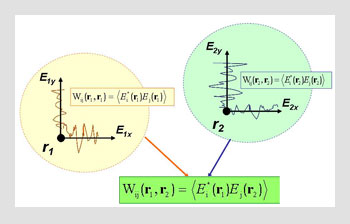Letters
Letters
 For optical fields transversal to the direction of propagation, the temporal fluctuations of the electric field at two positions r1 and r2 can be decomposed along orthogonal directions. When one inspects the 2 nd - order statistics, the field's properties are then described by all the possible correlations ‹E+E› between these random functions. This operation can be performed at one single spatial point and constitutes the essence of so-called Stokes polarimetry.
For optical fields transversal to the direction of propagation, the temporal fluctuations of the electric field at two positions r1 and r2 can be decomposed along orthogonal directions. When one inspects the 2 nd - order statistics, the field's properties are then described by all the possible correlations ‹E+E› between these random functions. This operation can be performed at one single spatial point and constitutes the essence of so-called Stokes polarimetry.
In addition, one can also examine mutual properties by evaluating the cross-correlations between fluctuations at two different points of the field (using some sort of interferometric approach).
In “Recent Advances in Cloaking” (June 2007), Didier Felbacq reports on mathematics and computer simulations, but does not address two persistent problems with the idea of using refractive methods to render an object invisible.
To understand these problems, consider a refractively protected “cloaked object,” which is to be made invisible at the arbitrary location of a person or optical system called the “detector,” some reasonable distance (millions of wavelengths) away.
First, conservation of energy: Light from objects behind the cloaked object must be refracted around it so that the detector sees only those objects. This implies that no light from those objects is to be absorbed by the cloaked object. Therefore, no system in the cloaked object can absorb this light; sensors in the cloaked object will be rendered completely blind to those objects.
Second, reversibility in an imaging system: All illumination sources must be treated the same way by cloaking technology. In particular, should the detector or anything else shine light through the cloaked object, the beam must be directed around it onto objects behind it, which then must be illuminated as though the cloaked object did not exist and reflect (scatter) back their light to the detector the same way. Therefore, cloaking refraction must be spatially symmetrical (omnidirectional) and will not work unless the system is symmetrical in three dimensions.
These problems imply that a cloaked object can admit no light from any direction. Any operation admitting light to the cloaked object must reduce the effectiveness of cloaking and render it more or less visible to the detector.
One might argue that light could be admitted to the cloaked object, used for vision, and then reconstituted reactively (and otherwise passively) by an optical system and some internal energy source. However, this implies an object to image in the cloaked object; so, the conservation of etendue law, which applies to all imaging systems, would forbid such reconstitution of the background while the cloaked object was cloaked.
One can conclude that no useful cloaking can be effected by refractive means alone. Instead, some other, perhaps adaptive, mechanism must be combined with, or substituted for, refractive cloaking. Presumably, an effectively cloaked object always will have to render itself visible from time to time or place to place to see and preserve consistency with the surroundings in which it is concealed. A smokescreen or dusty background would help.
John Michael Williams
Redwood City, Calif.
Log in or become a member to view the full text of this article.
This article may be available for purchase via the search at Optica Publishing Group.
Optica Members get the full text of Optics & Photonics News, plus a variety of other member benefits.
